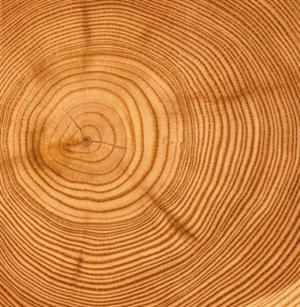| Complexity level: | 7 |
| Project cost ($): | 60 |
| Time required: | 1 day to prepare, 1 day for observation |
| Material availability: | Easily found |
| Safety concerns: | The oven should not be left unattended when the pieces of wood are left to dry in the oven for 24 hours. There is a possibility of the wood catching fire (although it is unlikely, if a proper temperature setting is used). Have fire safety equipment on standby. Be careful when removing the hot wooden blocks from the oven. Use gloves for protection. |
Hypothesis
Humidity will cause different types of wood to expand and shrink at different rates.
Overview
Expansion and shrinkage in woods
Trees contain water just like any other living organism. A freshly cut piece of wood has higher moisture content and is not suitable to be used as firewood nor is it suitable for woodworking purposes. These newly cut pieces of wood must first be dried in an oven or in an open space. The ideal condition of the wood is said to be achieved when there is a level of equilibrium in the humidity between the wood and its surrounding environment.
Wood tends to expand and contract. This is actually caused more by the changing humidity surrounding the wood rather than by thermal factors. A higher atmospheric humidity will cause the wood to expand while a lower humidity will cause the wood to shrink.
Changes in the dimensions of the wood are normally higher along its growth rings while the changes in the dimension of the wood along its length are normally negligible.
How much a certain species of wood changes in its dimensions by expanding or shrinking according to the surrounding humidity cannot controlled. Experienced wood workers and carpenters need to effectively understand this behavior of wood in order for them to effectively plan and implement projects.
Scientific Terms
Materials
The materials required for this science fair project:
- 1 redwood block (20mm x 10mm x 50mm)
- 1 teak wood block (20mm x 10mm x 50mm)
- 1 black oak wood block (20mm x 10mm x 50mm)
- 1 red maple block (20mm x 10mm x 50mm). You can purchase the wood from hardware stores such as Lowes and Home Depot
- 1 caliper
- 1 oven
- 1 pair of gloves
- 1 black marker pen
Procedure
1. For this science fair project, the independent variable is the type of wood used – redwood, teak, black oak and red maple. The dependent variable is the change in each block of wood’s dimensions when exposed to room humidity and after they have been dried in the oven. This is determined by measuring the dimensions of the wooden blocks with a caliper. The constants (control variables) are the size of the wooden blocks, the surrounding air humidity and the humidity inside the oven.
2. The preparation for the experiment is done by cutting the redwood, teak, black oak and red maple wood into wooden blocks measuring 20mm x 10mm x 50mm. The growth rings should be along the 20mm side. The dimensions of the wood are measured and recorded in the table given below.
3. The black marker is used to indicate the type of the wood on the wooden blocks.
4. The temperature of the oven is set to 100°C and the 4 types of wooden blocks are placed inside the oven. The wooden blocks are left in the oven for the next 24 hours and during this time all of the moisture in the wooden block should evaporate and the wood should dry.
5. Gloves are used to remove the hot wooden blocks from the oven after 24 hours. The dimensions of each of the dried wooden blocks are measured once more using the caliper and the results are recorded in the table given below.
Results
It is observed the all 4 types of wood showed significant shrinkage along their growth rings after they were dried in the oven. The biggest change was in the black oak wood and the least change in dimensions was observed in the redwood.
| Wood | Along the growth ring (mm) | Along the Radial (mm) | Along the length (mm) | ||||||
| Normal | After oven dry | % change | Normal | After oven dry | % change | Normal | After oven dry | % change | |
| Redwood | 20.1 | 19.4 | 3.48% | 10.1 | 9.8 | 2.97% | 50 | 49.9 | 0.20% |
| Teak | 20 | 19.1 | 4.50% | 10.1 | 9.7 | 3.96% | 50 | 49.9 | 0.20% |
| Black oak | 20.1 | 18.4 | 8.46% | 10 | 9.2 | 8.00% | 50.1 | 49.9 | 0.40% |
| Red maple | 20.2 | 18.7 | 7.43% | 10 | 9.4 | 6.00% | 50.1 | 49.9 | 0.40% |
Conclusion
The hypothesis that humidity may cause different types of wood to expand and shrink at different rates, is proven to be correct.
It is much easier to work with a dry piece of wood than a freshly cut piece of wood. When moisture has been removed from the wood, it is lighter and easier to work with and handle. Kiln-dried wood is also easier and more cost effective to handle, store and ship to other places or countries. Dried wood is also easier to cut. Furthermore, the wood strengthens as it dries.
Also consider
Try using more than 1 piece of each type of wood for the experiment, for more accurate results.
Try this science fair project with other types of woods such as birch, fir, pine or hemlock.
Try exposing the wood to different levels of humidity in a humidity chamber and compare the rate of expansion for each type of wood.
References
Wood movement - http://www.woodworkerssource.com/wood_movement.php
Allowing for expansion and shrinking - http://woodworking.about.com/od/dealingwithproblems/p/expansion.htm

